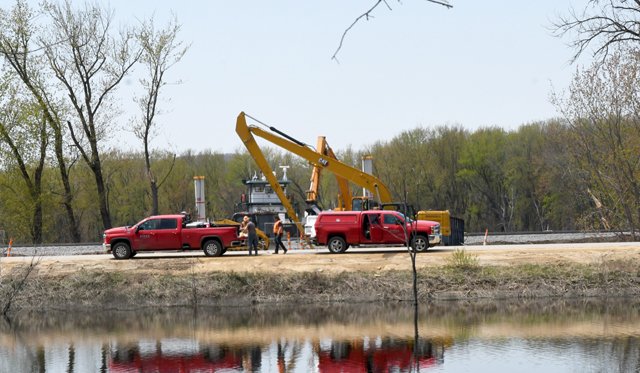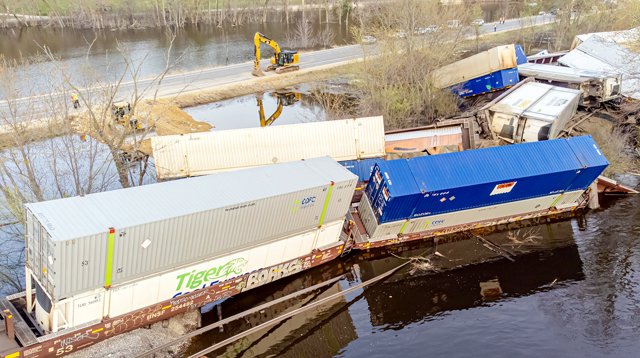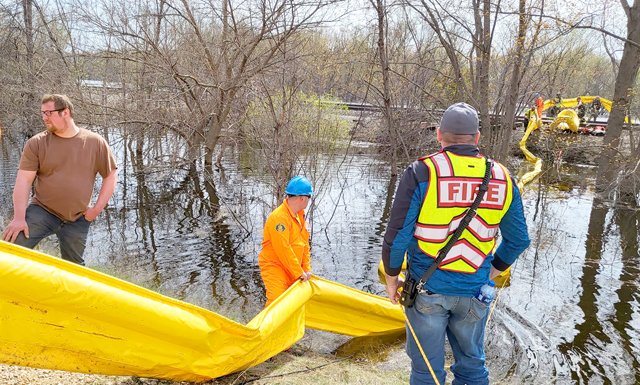DE SOTO - The derailment of a southbound Burlington Northern Santa Fe train just south of DeSoto on Thursday, April 27, at 12:15 p.m., sent 20 railroad cars and two locomotives off the tracks.
Many rail cars and the shipping containers strapped to them slumped into the adjacent water. Four injured BNSF workers were rescued by the responding Ferryville Fire Department–none suffered life-threatening injuries.




As of Sunday, April 30, train traffic was resumed, according to Crawford County Emergency Management (CCEM) Director Jim Hackett.
“Burlington Northern Santa Fe has been cleared to resume rail traffic by the Federal Railroad Administration (FRA),” Hackett said.
The county’s director of emergency management also communicated in a Facebook post on Sunday, April 30, that Highway 35 from DeSoto south to County B is expected to remain closed to traffic until at least Wednesday, May 3.


Derailed containers from the DeSoto incident, which were reported to contain paint, floated away in the Mississippi River, passed underneath bridges along the Dike last week, before becoming mired along the shoreline to the south.


On the day of the derailment, flooding on the Mississippi River was at levels qualifying for a ‘top five flood levels’ from LaCrosse to Prairie du Chien. At Genoa, the flood was #4 at 635.72 feet, a level not seen since April 20, 1969 at 635.24 feet.
Just down river at Lansing, the flood level was at 19.61 feet, on its way to a #4 flood at 19.7 feet, a level not seen since April 21, 1969, at 18.88 feet. At Lynxville, the flood level was at 630.26, on its way to a #4 flood at 630.4 feet, a level not seen since April 22, 1969, at 629.42 feet. And at McGregor, Iowa (Prairie du Chien), the level was at 22.91 feet, on its way to a #3 flood at 22.9 feet, a level not seen since April 20, 2001, at 23.75 feet.
In addition to having the Mississippi River to its west, the railroad tracks on the raised bed have a waterway to the east separating it from Highway 35. The rail cars involved were carrying lithium ion batteries, paint and other cargo.
On the evening of Thursday, April 27, DeSoto Fire Chief Chris Mussatti stated, in an interview with television media, that he does not believe the derailment was caused by flooding.
“If it had been caused by flooding, then we would also have been having problems with Highway 35,” Mussatti said.
Despite those claims from the chief, it should be noted that a derailment just south of the current incident occurred in 2016, when Rush Creek jumped out of its banks and rushed across Highway 35 with substantial depth and current, taking out a BNSF trestle, but it did not damage the roadway.
Furthermore, local roadways of all sizes have often survived feet of flooding for lengthy periods of time, with little or no consequences.
Chief Massatti said that his primary concern after arriving on scene was to determine what the contents of the derailed cars were. He said local agencies did their best, and “waited for the cavalry to come.”
“Our local fire department doesn’t have the capacity to fight a toxic spill,” Massatti said. “The only contents in the cars that could have been explosive were oxygen cylinders, but fortunately no explosion happened.”
Massatti said he remembers four other derailments along the river since about the 1990s, but said that responding to this one was trickier because of its location.


Images captured by LaCrosse Aerial Photography clearly show a section of the tracks closer to the river with only water beneath it. That image was captured on day two of the incident – Friday, April 28. The image also reveals water under the tracks that the derailed train was travelling on and two of the derailed train cars.
According to Hackett, neither Crawford County nor the State of Wisconsin has authority to shut the railroad tracks down in the event of flooding. The tracks are located on private property owned by BNSF. The FRA sets the standards by which the railroad company must inspect their tracks, when trains can be run on the tracks, and when the tracks must be shut down.
“BNSF was monitoring and inspecting lines through Crawford County during the flood,” Hackett explained. “The FRA is doing a full investigation into the derailment.”
Hackett stated that, according to the FRA, inspections (of the tracks in Crawford County) were completed and all guidelines that the FRA has provided to BNSF have been followed.
Hackett went on to explain that Wisconsin DOT made the decision to shut down Highway 35 because it is the only way for BNSF to access the tracks at the derailment location to make repairs. He said that in addition, stretches of Highway 35 south to County B are closed due to the high volume of heavy truck traffic carrying rock to the derailment site.
According to Hackett, all costs of the recovery and clean up of the derailment will be paid for by BNSF.


Hazardous materials
In an interview with TV news reporters on Thursday, April 27, Vernon County Emergency Management Director Brandon Larson explained that his team’s assistance was requested by CCEM for the initial ‘hazmat’ (hazardous materials) response to the site. He said that they were quickly in contact with BNSF Hazmat to identify the exact contents of each rail car involved to determine if there were hazardous or explosive contents.
“The only dangerous hazards would have been if the lithium ion batteries contained in the railroad car had come into contact with water or if the oxygen cylinders had exploded,” Larson said. “Those things did not happen, and we deployed booms to soak up the fuel leaks into the water.”
One DeSoto resident, Pat Ferguson, was out on Old Highway 35 on Friday, April 28, watching the recovery efforts.
“If those cars had been carrying hazardous materials, then I think DeSoto would have been severely impacted,” Ferguson said. “We got lucky this time.”


Governor responds
On Friday, April 28, Governor Tony Evers visited the site of the derailment. He was flown in by a Wisconsin National Guard Blackhawk Helicopter. Wisconsin Department of Transportation Secretary Craig Anderson and Wisconsin Railroad Commissioner Don Vruwink had responded to the scene on Thursday.
“The highway closures constitute a huge imposition for local residents,” Evers stated. “Our local first responders and emergency management did an outstanding job in responding to this emergency – they were on the scene first along with local Department of Natural Resources staff, and did exactly what they had trained to do in a situation like this.
Crawford County Emergency Management has overall command of the incident, and all requests for assistance go through them. Initially it was a co-incident command’ with the Ferryville Fire Department and Fire Chief Al Novak. When DeSoto Fire Chief Chris Massatti arrived on scene, then command transitioned from Ferryville to DeSoto Fire Department.
It was the Ferryville Fire Department that rescued the four railroad employees in a inflatable ‘banana’ boat, and ensured they were given access to medical treatment. Three of the four were uninjured, with one suffering a broken collarbone, according to Governor Evers.
“The most amazing thing is that CCEM only requested one state resource in our initial response – a boat from Wisconsin DNR,” Hackett said. “Every other resource was a local resource until BNSF took over the hazmat operations.”
Hackett said agencies involved in the initial response included Crawford County Emergency Management, Crawford County Highway Department, Crawford County Sheriff’s Office, Vernon County Sheriff’s Office, Wisconsin Department of Natural Resources, Vernon County HazMat, Vernon County Emergency Management, Tristate Ambulance, Gundersen Ambulance, Ferryville Fire Department, Desoto Fire Department, Wheatland Fire Department, Burlington Northern Santa Fe Police, Genoa Fire Department, Wisconsin State Patrol Aerial Unit, Harpers Ferry Fire Department, and Prairie du Chien Fire Department.
As of Friday, April 28, staff from both Wisconsin DNR and U.S. Environmental Protection Agency were seen at the site of the derailment.
Safety improvements
When asked by one television reporter what the State of Wisconsin can do to improve railway safety, Evers had this to say.
“Accountability for this situation will happen,” Wisconsin Governor Tony Evers said on Friday from the derailment site. “We have to wait for federal agencies to determine how this happened, before we can assess what we can do to improve things.”
Wisconsin State Senator Brad Pfaff said that after the train derailment in Palestine, Ohio, Pfaff had been in contact with the new Wisconsin Commissioner of Railroads, according to a story by Melissa Collum of the Prairie du Chien Courier Press.
“I reminded him that every mile, north to south along the Mississippi, in my state senate district is the rail line. We need to make sure that we have proper oversight of the railroad,” Pfaff said.
Pfaff also met with Wisconsin Emergency Management and the WDOT after the East Palestine derailment, to stress the need for oversight and communication.
“We need to make sure there is the funding for rail monitoring and inspection. I look at the most recent budget vote that took place in Washington D.C., and we need to make sure that we are funding programs.”
President Joe Biden’s 2024 Budget calls for an investment of over $1 billion to expand the U.S. Department of Transportation’s Federal Railroad Administration’s core safety efforts, and improve critical rail infrastructure.
Pfaff, with other government officials, have been in conversations with representatives from the BNSF Railway as well.
“When we spoke to the vice president of the railroad, he indicated that they are always evaluating and always monitoring the rail service. They stated they had a train that had gone through just 30 minutes prior to the derailment. There is going to be an awful lot of review that is going to be done,” Pfaff said.
One of the main aspects that Pfaff pointed out is the need for clear communication between the railroad and local communities.
“They [the railroad] need to recognize the seasonality of the weather and what is taking place. To just say they have done something the way they have always done it ignores the fact that what we are seeing here is very serious,” Pfaff pointed out.
Pfaff emphasized that communication with local first responders is of utmost importance. Earlier, he had toured the DeSoto derailment with Governor Evers and Wisconsin State Representative Loren Oldenburg.
“We need to make sure that we hold the railroad corporations accountable,” Pfaff said. “They are on site right now, and they are doing their best to make sure that the clean-up is done safely, effectively, and in a timely manner. But, there needs to be oversight.”
Melissa Collum, editor of the Courier Press in Prairie du Chien, contributed to this story.





